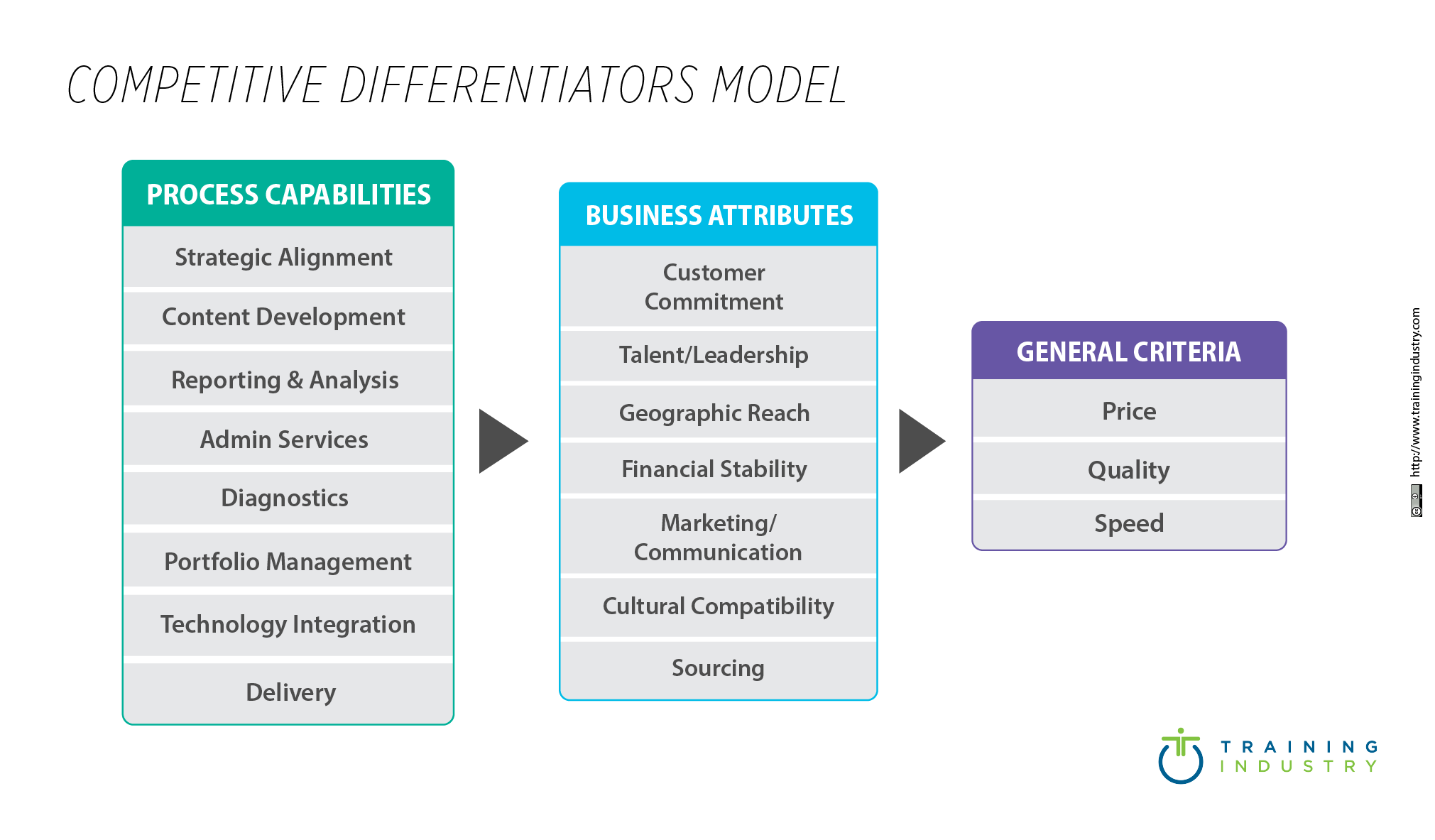DEFINITION
The Competitive Differentiators Model defines the eight process capabilities, seven business attributes and three defining factors that differentiate suppliers in the training market.
OVERVIEW
This model was originally created in 2009 by Training Industry, Inc. as a tool to assist buyers of training services in understanding how training suppliers differ, based on their inherent capabilities and how they market their services to the industry.
The model was developed with the underlying principle that all training suppliers are not the same, and therefore not equipped or capable to handle every type of training engagement. By understanding a supplier’s capabilities, attributes and strategies surrounding price, quality and speed, a buyer can better select the most appropriate supplier to suit their organization’s needs.
Training Industry research reveals that all suppliers have a unique identity or persona. This identity is created either intentionally through a structured marketing strategy or plan, or indiscriminately through behaviors or action. Indiscriminate behaviors include language they use in brochures, magazine ads, sales meetings, presentations, website design, etc.
Together, these behaviors create an identity that allows buyers to evaluate a company’s market strategy, as well as their “true” ability to deliver certain services. Research also shows that suppliers position themselves in various ways to appeal to different buyer segments.
Ultimately, it is a buyer’s responsibility to be diligent when evaluating a supplier’s demonstrated capabilities. This will ensure that buyers select the right supplier for their particular engagement. The better a buyer understands how to assess a supplier based on these criteria, the more prepared they will be to determine which company best fits their business and training needs.
COMPETITIVE FACTORS
The Competitive Differentiators Model consists of three competitive factors:
-
- Process Capabilities: A supplier’s ability to successfully perform the processes inherent to the engagement
-
- Business Attributes: A supplier’s ability to meet the business’ viability, scope and scale requirements
-
- General Criteria: A supplier’s ability to meet the buyer’s needs relative to price, quality and speed
HOW TO EVALUATE SUPPLIERS
The model recommends that buyers evaluate a supplier through three simple steps.
- Ensure that the supplier has the capabilities to adequately and successfully deliver and manage the processes required for the engagement.
- Determine whether the suppliers meet the necessary business criteria. For example, are they financially stable? Do they have the talent to successfully perform at the level you expect? Are they culturally compatible to your industry or constituents?
- Determine which is most important to your business — price, quality and/or speed — and then evaluate the suppliers based on the most important criteria to your business.
PROCESS CAPABILITIES
This area includes eight process capabilities that are aligned with the Training Process Framework, each of which is described below.
- Strategic alignment: The capability of a supplier to ensure that all activities are strategically aligned with the clients business objectives.
- Content development: The capabilities of a supplier to design, develop and manage learning-based content.
- Reporting and analysis: The capability of a supplier to measure and report on the performance and effectiveness of learning services.
- Administrative services: The capability of a supplier to administratively manage the logistics and day-to-day activities of a training organization. Processes included in this area are: scheduling and registration services, tuition reimbursement, client relationship management, and strategic management.
- Diagnostics: The capability of a supplier to assess the current state of the organization and recommend solutions to improve performance.
- Delivery: The capability of a supplier to provide end-to-end instructional delivery services, including instructor recruitment, development, delivery and feedback.
- Portfolio management: The capability of a supplier to manage libraries of courses and ensure that each are aligned to the businesses objectives and to individual learners’ needs.
- Technology integration: The capability of a supplier to manage the integration of learning-based technologies with the enterprise’s internal HR and ERP platforms.
Suppliers typically differentiate themselves through one of these eight processes, since these capabilities are what buyers are actually purchasing.
BUSINESS ATTRIBUTES
The model recognizes that suppliers also distinguish their organizations based on other factors, such as size, geographic reach, talent level and more. These competitive factors are called business attributes. There are seven business attributes used when evaluating a supplier’s capabilities, each of which is described below.
- Talent and leadership: The supplier’s ability to deliver services based on the level of talent in both the leadership ranks, as well as the tactical delivery of services.
- Geographic reach: The supplier’s ability to deliver services based on the location of resources.
- Customer commitment: The supplier’s ability to demonstrate they are committed to a customer’s particular needs.
- Financial stability: The supplier’s ability to meet the financial requirements of a particular engagement.
- Marketing and communications: The supplier’s ability to provide marketing and communication support and their channel strength.
- Cultural compatibility: The supplier’s ability to demonstrate their organization is culturally compatible to the buyer’s culture.
- Sourcing: The supplier’s ability to demonstrate they have the sourcing power and strength to leverage secondary resources.
GENERAL CRITERIA
This area includes price, quality and speed (or timeliness) of delivery. Although these criteria are the most common used to evaluate suppliers, they should be considered after verifying that a supplier has the required process capabilities and business attributes.
SUPPLIERS’ PERSPECTIVE
The use of the Competitive Differentiators Model has evolved into a tool to assist training suppliers, as well. Suppliers can use the model to help determine how to differentiate their business and capabilities in the training market. The market for training suppliers is highly fragmented, with little differentiation among many suppliers. Those suppliers who position their business by providing best practices within key process areas, along with essential business attributes, can more effectively compete on price, quality or speed.

